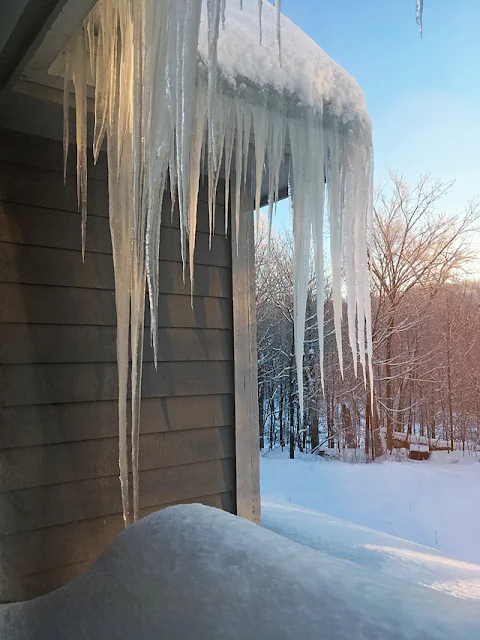Osiris Rising

Winter began at the end of January. The low temperature, early Wednesday morning, January 30, bottomed at -34℉ with a high temperture of -16℉. In February, temperatures did not get very much above 10℉, and were often below zero.
My wife described these low temperatures in this way -one feels surrounded. Imagine you stepped outside of your plane on a flight across country...
When it's minus thirty you can play around with making clouds with boiling water.

I retreated to Cedar Creek Ecosystem Science Reserve one last time to work on some writing. The moon rose, and later that night, the second of several significant snowfalls began.

The snow piles higher; sliding off roofs, snow blown, and accumulation.
The icicles grow longest on the upper floors -some over six feet long.
Ice dams form where house heat melts roof snow, where the weight of snow compresses it at the edges of a roof.
By February 20th we had the snowiest February on record -with still more snow to come. By the same date, however, one begins to think of what else may come -warmth! With it comes melting, wet snows, even rain. The weight on the roof is probably okay under the cold regime, but snow is like a sponge -lighter when dry and heavier when wet. Ordinarily welcome, the warmth could become a problem.
It is easy to imagine the return of glacial lake Agassiz, forming as rainfall accumulates between
a snow pack of thirty inches, four foot snow mounds, and the frozen
ground. I begin to clear areas previously left untouched -in front of the greenhouse, the sidewalk between the house and front yard and six feet beyond the walkway between the house and the backyard.

I even cleared a path to the compost pile -you can almost make it out on the far right, above. This was to keep us from trudging knee deep to dump the bucket, but also to give the melt water a place to travel down slope, away from the house.

Then it was time for the inevitable: clearing the roof. Wind helped keep some edges below sixteen inches, but other spots were above eighteen inches. This view is akin to a core sample -each storm depositing more snow, compressing under the weight of the next. The upper portion is the thickest and lightest, the bottom crispy and snow-cone like.

One of my better purchases: insulated rubber boots: good to -20℉.

When climbing out a window into a thirty inch snow drift, mind the space above your head. This icicle was disturbed by my head, broke, and dropped on my noggin -not a good way to start shoveling snow off of the roof.

On March 10 we woke up to another six or seven inches of snow. This time the temperature was in the mid to high twenties and the snow sticky: aka wet snow -a sign of things to come.

A six foot tall azalea has little positive things to say about six inches of wet snow. We have noticed that between -30℉ and 30℉, the azalea leaves change form. Warmer temperatures show leaves that are open wide and flat. At colder temperatures, the leaves are tightly rolled.

By Tuesday, March 12, the air was a warm and dewy 37℉. That's when the rain started to fall. By Wednesday, we had a morning fog with near white out conditions. It continued to rain through Thursday -leading to flood reports across several Midwestern States.
There is little moderation in the Midwestern climate -at times, we can span 70 degrees in a couple of days. On the coasts, even within a three week period, to experience below zero temperatures at the beginning and sixty degrees Fahrenheit at its end, is unheard of. With over thirty inches of snow on still frozen ground across the entire state, days of rain, and the increasing temperature to near 60℉ by Saturday, we will see large scale flooding.

Like Osiris rising from the dead, so too is spring. The geese were heard flying over just a few days ago. The birds, winter friendly, are spring noisy. The popping of basswood, Tilia americana, trunks were heard echoing among the woods on a sunny afternoon of twenty-five degrees -calling us out to tap sugar maples for sap.
From winter weather to spring in bird song.





Comments
Post a Comment
Go ahead and comment! I will moderate and delete the spam. Thx